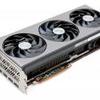Introduction
Sapphire Radeon RX 7800 XT Nitro+ review
Sapphire introduces the NITRO+ RX 7800 XT graphics card, designed with a minimalist aesthetic and optimized for performance. It boasts a 14-phase power delivery system distributed across a 14 Layer High TG PCB reinforced with 2 Oz Copper. With a 2565 Boost frequency, 288 TBP, and 236W TGP, the card aims for efficiency. Relative to the reference design, this 3-slot variant can achieve a slightly elevated clock speed. Notably, the product is equipped with dual 8-pin power connectors. The Radeon 7800 XT with its 16GB 256-bit memory configuration at 19.5 Gbps, is bound to impress. This particular iteration is poised to utilize the complete 60 CU / 3840 Shader processors setup of the GPU and boasts a Total Board Power (TBP) of 263W. The AMD Radeon RX 7800 XT GPU is built upon the Navi 32 SKU framework and thus chiplets, incorporating four Memory Controller Domains (MCDs). The GPU core boasts 3840 cores, meticulously distributed across 60 Compute Units to enhance performance. Additionally, the GPU incorporates a substantial 64 MB Infinity Cache, functioning at an 18 Gbps pin speed, yielding a commendable total bandwidth of 576 GB/s. The second Navi 32 variant, aka Radeon RX 7700 XT, sees a friendly 54 CU/3456 shader processor configuration, complemented by 12GB memory on a 192-bit bus running at an effective 18 Gbps data rate. This points towards a Navi 32 iteration with one of the four MCDs disabled, resulting in 48 MB of Infinity Cache. The core setup of the RX 7700 XT is anticipated to encompass approximately 54 Compute Units, housing a total of 3456 stream processors.
| AMD Radeon RX 7000 Specifications | |||||
|---|---|---|---|---|---|
| Radeon RX | 7900XTX | 7900 XT | 7800 XT | 7700 XT | 7600 |
| Architecture | RDNA3 (TSMC N5) | RDNA3 (TSMC N5) | RDNA3 (TSMC N6) | RDNA3 (TSMC N6) | RDNA3 (TSMC N6) |
| GPU | Navi 31 XTX | Navi 31 XT | Navi 32 XL | Navi 32 XT | Navi 33 |
| GPU Clusters | 96 CUs | 84 CUs | 60 CUs | 54 CUs | 32 CUs |
| FP32 Cores | 6144 | 5376 | 3840 | 3456 | 2048 |
| Game Clock | 2.3 GHz | 2.0 GHz | 2.124 GHz | 2.171 GHz | 2.25 GHz |
| Boost Clock | 2.5 GHz | 2.4 GHz | 2.43 GHz | 2.54 | 2.625 GHz |
| Memory | 24GB G6 | 20GB G6 | 16GB G6 | 12 GB G6 | 8GB G6 |
| Memory Bus | 384-bit | 320-bit | 256-bit | 192-bit | 128-bit |
| Memory Speed | 20 Gbps | 20 Gbps | 19.5 Gbps | 18 Gbps | 18 Gbps |
| L3 Cache | 96 MB | 80 MB | 64 MB Gen2 | 48MB Gen2 | 32 MB Gen2 |
| Board Power | 355W | 315W | 263W | 245W | 165W |
| Power Connectors | 2 × 8-pin | 2 × 8-pin | 2 × 8-pin | 2 × 8-pin | 1 x 8-pin |
| PCIe Interface | Gen4 x16 | Gen4 x16 | Gen4 x16 | Gen4 x16 | Gen4 x8 |
| MSRP | $999 | $899 | $269 | ||
| Launch Date | December 2022 | December 2022 | September 2023 | September 2023 | May 2023 |
The 2565 Mhz boosted Nitro+ features a silver shroud and backplate, offering a modern aesthetic. One can observe that the RX 7800 XT NITRO+ has grown in size, approaching three slots in width. The card incorporates substantial ARGB LED strips on the top side, which can be customized via the Sapphire TRIXX software. Additionally, there's an RGB connector present for those who wish to synchronize their lighting configurations with additional peripherals. In terms of features consistent with other models, like the NITRO and NITRO PURE series, this card is also equipped with a dual-BIOS switch. The NITRO+ introduces a distinct I/O layout, supported by three 8-pin power connectors. In contrast to AMD's MBA cards, this model is designed with two HDMI 2.1 connectors and two DisplayPort 2.1 ports, marking it as the first card with such a dual DisplayPort configuration. Emphasizing durability and quality, the NITRO branding incorporates a durable die-cast frame, integrated with an aluminium backplate and shroud, enhancing its structural rigidity. To optimize thermal management, the card employs a tri-fan cooling mechanism that promotes enhanced airflow around the backplate's perimeter. By default, the card operates in performance mode, delivering a performance increase of 3% to 4% over standard reference cards. Notably, the Radeon RX 7800 XT will utilize conventional 8-pin PCIe connectors, necessitating two such connectors, rather than adopting the 12VHPWR port.


